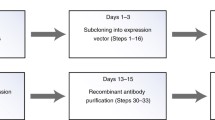Abstract
An expression system is described whereby a gene product is expressed fused to an antibody Fab fragment to form an antibody-like molecule The antigen binding function of the original antibody is retained and the foreign gene replaces the CH2 and CH3 regions of the heavy chain. The fusion protein is secreted as if it were an antibody, and can be purified using the antigen-binding function of the Fab-Iike part of the molecule. In principle any open reading frame can be expressed and it is not necessary to develop an individual purification scheme, or any analytical reagents such as antibodies, for the expressed protein, as both these functions can be performed by the Fab part of the fusion protein. In practice, the nature of the nonantibodv part of the fusion influences the efficiency of expression and secretion, and detailed guidance is given on trouble-shooting and maximizing expression.
Similar content being viewed by others
References
Neuberger, M. S., Williams, G. T., and Fox, R. O. (1984) Recombinant antibodies possessing novel effector functions.Nature 312, 604–608.
Williams, G. T. and Neuberger, M. S. (1986) Production of antibody-tagged enzymes by myeloma cells: Application to DNA polymerase I Klenow fragment.Gene 43, 319–324.
Mulligan, R. C. and Berg, P. (1981) Selection for animal cells that express theEscherichia coli gene coding for xanthine-guanine phosphoribosyltransferase.Proc. Natl. Acad. Sci. USA 78, 2072–2076.
Lundblad, A., Steller, R., Kabat, E. A., Hirst, J. W., Weigert, M.G., and Cohn, M. (1972) Immunochemical studies on mouse myeloma proteins with specificity for dextran or for levan.Immunochemistry 9, 535–544.
Oi, V. T., Morrison, S.L., Herzenberg, L. A., and Berg, P. (1983) Immunoglobulin gene expression in transformed lymphoid cells.Proc. Nat. Acad. Sci. USA 80, 825–829.
Hames, B. D. (1981) An introduction to polyacrylamide gel electrophoresis, inGel Electrophoresis of Proteins: A Practical Approach (Hames, B. D. and Rickwood, D. J., eds.), IRL, Oxford, pp. 1–91.
Walker, J. M. (1994) Gradient SDS polyacrylamide gel electrophoresis, inMethods in Molecular Biology, vol. 32: Basic Protein and Peptide Protocols (Walker, J. M., ed.), Humana, Totowa, NJ, pp. 35–38.
Author information
Authors and Affiliations
Rights and permissions
About this article
Cite this article
Forster, S.J., Carr, F.J., Harris, W.J. et al. Expression of foreign genes in mammalian cells using an antibody fusion system. Mol Biotechnol 1, 251–263 (1994). https://doi.org/10.1007/BF02921693
Issue Date:
DOI: https://doi.org/10.1007/BF02921693




